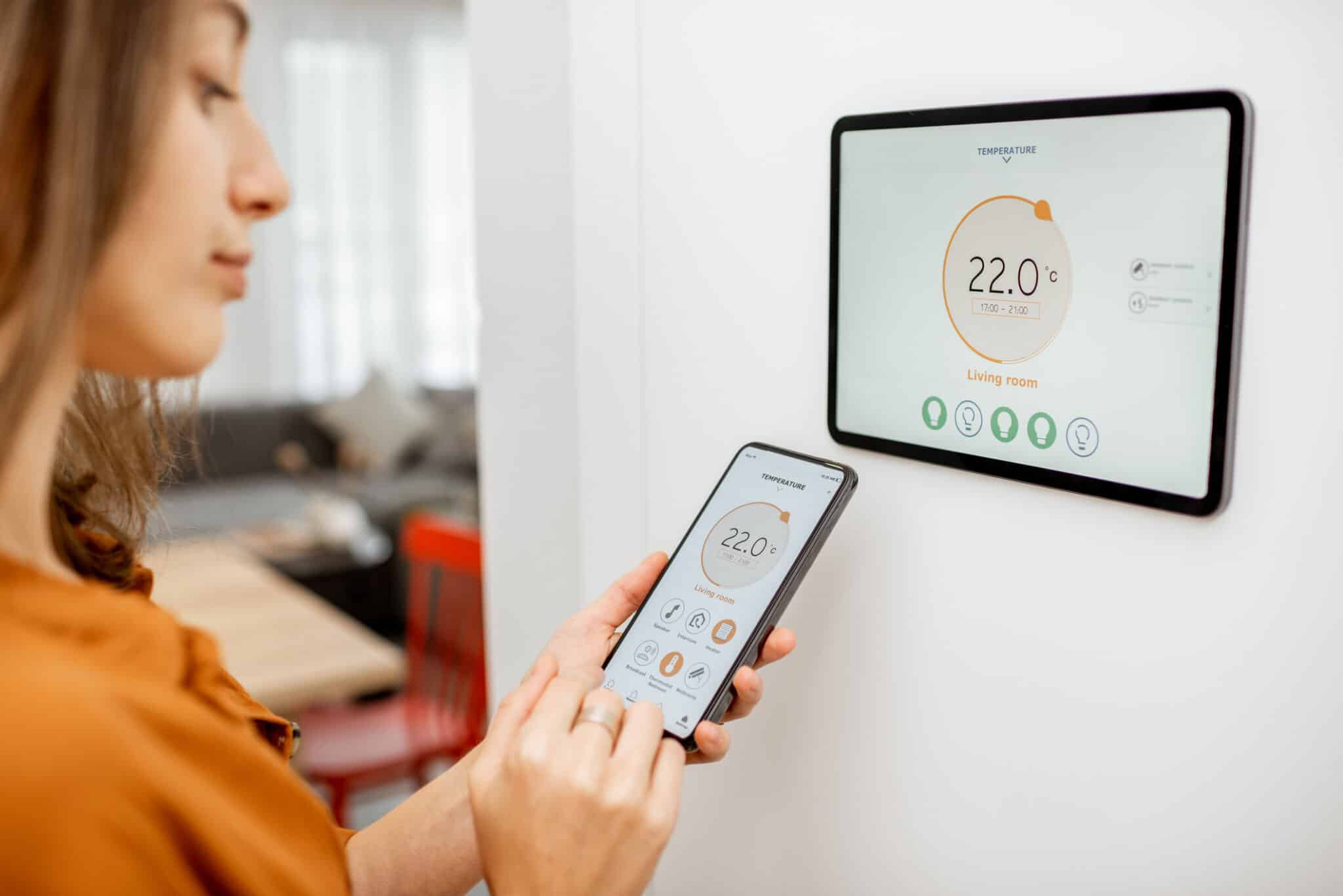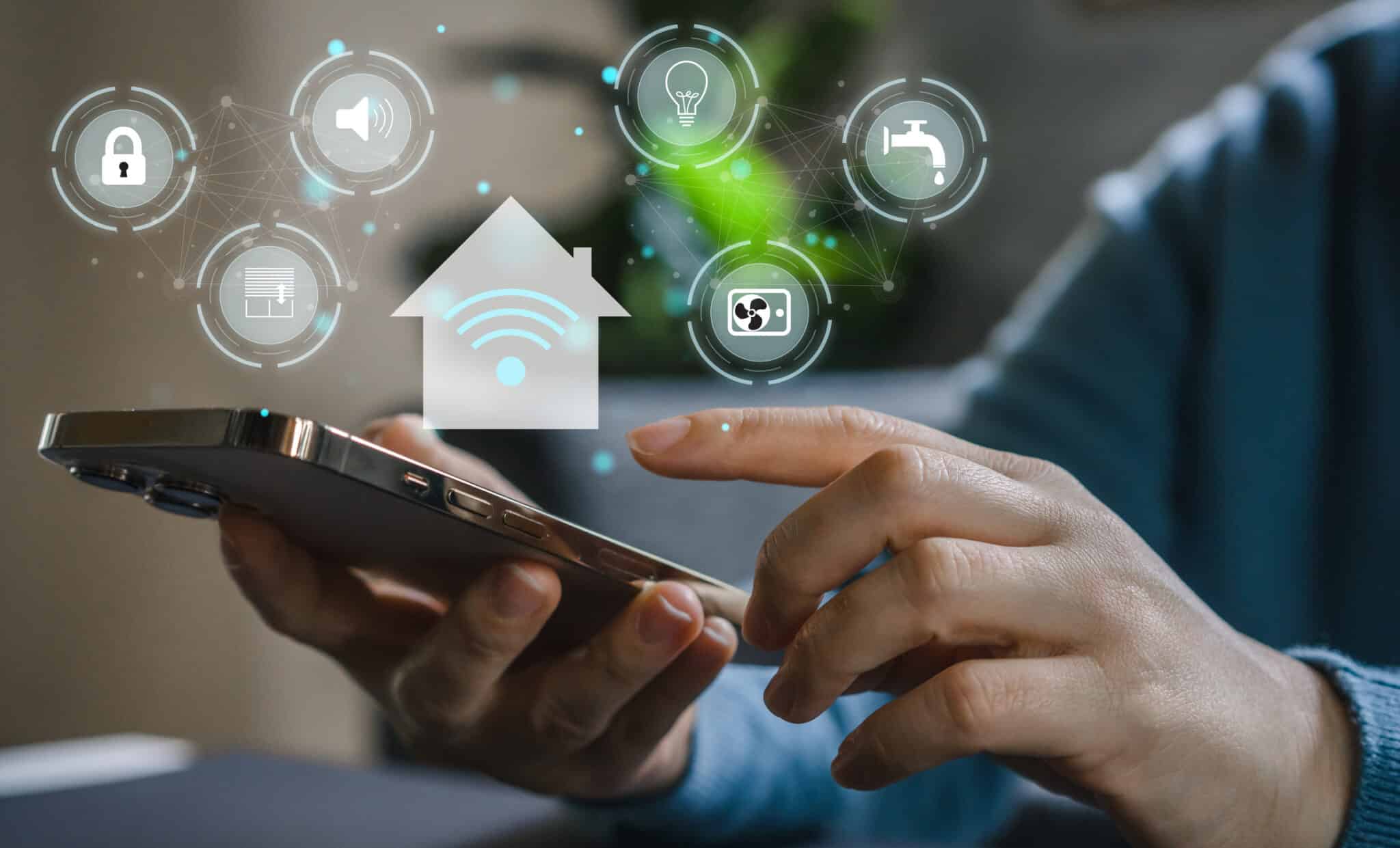Have you ever wished your air conditioning system could just “know” when to cool your home? With modern home automation, this wish isn’t just a dream anymore! Imagine your air conditioner turning on automatically before you get home from work, adjusting itself based on the time of day, or even responding to voice commands.
Whether you’re looking to make your home more comfortable or cut down on energy bills, integrating air conditioning with a smart home system offers endless benefits. Ready to find out how it works? Let’s explore!
What is Home Automation?
Home automation is all about making your home smarter by connecting devices like lights, security cameras, and air conditioners into one centralized system. With home automation, you can control everything through your smartphone, tablet, or even by using voice commands.
This technology allows you to create custom settings, like turning on your air conditioner at a specific time each day or adjusting the temperature when no one is home.
The result is a home that not only operates more efficiently but also offers enhanced comfort and convenience. Integrating your air conditioning system into a home automation setup is a game-changer, especially in warm climates like San Diego, CA, where keeping your home cool is essential.

Understanding Air Conditioning Systems
Air conditioning systems are designed to regulate the temperature, humidity, and overall air quality of your home. There are various types of air conditioning units, each tailored to different needs and spaces.
Whether you’re looking to cool a single room or your entire house, choosing the right type of system is essential for effective cooling and comfort.
When integrated with home automation, these systems become even smarter, offering enhanced control and improved efficiency. Let’s explore some of the most common types of air conditioning systems available for homeowners.
Types of Air Conditioning Systems
There are different types of air conditioning systems to choose from, each with unique features and benefits. Your choice will depend on factors like the size of your home, budget, and cooling needs. Below are the most common types of air conditioning systems:
- Central Air Conditioning: Central air conditioning is ideal for cooling an entire home using a system of ducts and vents. It uses a central unit that distributes cool air evenly throughout every room. This system is highly efficient for larger homes, providing consistent cooling. It’s a popular option in regions with hot climates, as it can easily maintain a comfortable temperature.
- Ductless Mini-Split Systems: Ductless mini-splits are perfect for homes without ducts or for adding cooling to individual rooms. Each unit operates independently, allowing for different temperature settings in each room. They are energy-efficient and easy to install, making them a good choice for small homes or add-ons. They’re also quieter than traditional systems and take up less space.
- Window Units: Window units are compact and ideal for cooling a single room. They are installed directly into a window and can be easily moved if needed. Although less powerful than central or ductless systems, they are a budget-friendly option. These units are perfect for renters or homeowners looking for a temporary solution.
Understanding the different types of air conditioning systems helps you make the best choice for your needs, especially when planning to integrate them with home automation.
How Air Conditioning Systems Work
Air conditioning systems work by removing heat and moisture from the air to create a cooler indoor environment. The process starts with a refrigerant, a special chemical that absorbs heat from inside your home and releases it outside.
The system’s components — including the compressor, condenser, and evaporator — work together to circulate this refrigerant through a series of coils.
As the refrigerant changes from a liquid to a gas and back, it absorbs and expels heat, cooling the air inside your home. Understanding how your air conditioning system works is essential for optimizing its performance, especially when integrating it with a smart home setup.
Benefits of Integrating Air Conditioning with Home Automation
Integrating your air conditioning system with home automation isn’t just about convenience; it offers numerous benefits that can transform your home environment.
By making your air conditioning system smarter, you gain more precise control, improve energy efficiency, and have the ability to monitor and adjust settings remotely.
This means a more comfortable home, lower energy bills, and the peace of mind of knowing you can manage your system from anywhere. Let’s dive into the specific advantages of merging air conditioning with a smart home setup.
Enhanced Comfort Control
With home automation, your air conditioning can adapt to your preferences throughout the day. You can set personalized schedules based on your routine, like cooling your home before you wake up or making it warmer when you’re away.
Smart thermostats can even learn your habits over time and automatically adjust the temperature to keep your home just the way you like it.
For example, in a place like San Diego, CA, you can maintain a cool home during hot afternoons and ensure a cozy atmosphere for evenings without manually adjusting the settings. This seamless control means you always have the perfect temperature at home.
Energy Efficiency and Cost Savings
Smart air conditioning systems don’t just make your home more comfortable — they can also help you save money. By using smart thermostats and sensors, your system can detect when rooms are empty and adjust the cooling accordingly. This prevents unnecessary energy use, leading to lower utility bills.
Additionally, smart features like energy reports help you track and optimize your usage, making it easier to see where you can save even more. These small adjustments can add up to significant savings, especially during peak usage seasons.
Remote Access and Monitoring
One of the biggest perks of integrating your air conditioning with home automation is the ability to control it from anywhere. With your smartphone or tablet, you can check the status of your system, adjust the temperature, and even turn it off if you forget before leaving.
This is especially useful for ensuring your home is comfortable when you return from a long day or while you’re on vacation. You’ll also receive alerts if something goes wrong, like sudden temperature changes or maintenance issues, allowing you to address problems quickly and avoid costly repairs.
Key Components for Integration
Integrating your cooling system with a home automation setup requires a few essential components. These devices work together to give you control over your home’s climate, making it smarter and more responsive.
The right equipment not only enhances comfort but also optimizes energy use. Let’s take a look at the key components needed to get started.
Smart Thermostats
Smart thermostats are the backbone of any automated cooling system. They allow you to set schedules, adjust temperatures remotely, and even learn your habits to maintain optimal settings.
Many models also provide energy usage reports, helping you track consumption and identify areas for improvement. Plus, with voice assistant compatibility, you can control the temperature simply by speaking, adding an extra layer of convenience.
Smart Sensors
Smart sensors can be placed around your home to detect changes in temperature, humidity, or even occupancy. These sensors communicate with your main thermostat to adjust settings based on real-time conditions.
For example, if a sensor detects that no one is in a particular room, it can signal the system to reduce cooling in that area, saving energy. This targeted control ensures that you’re only using energy where it’s needed.
Home Automation Hubs
The home automation hub is like the “brain” of your smart system, connecting all your devices together. Whether it’s a thermostat, sensor, or even lighting, the hub allows them to communicate and work in harmony.
By linking your cooling system to a hub, you can create custom scenarios, like turning on the air and closing the blinds simultaneously when temperatures rise. This central control makes it easy to manage multiple devices from a single platform.
Steps to Integrate Your Air Conditioning with Home Automation
Integrating your cooling system with a smart home setup might seem complicated, but breaking it down into simple steps makes it much easier.
By following a structured approach, you can ensure that each device connects seamlessly and works together to create a comfortable, energy-efficient environment. Here’s a step-by-step guide to help you get started.
Assess Your Current Air Conditioning System
Before jumping into smart upgrades, it’s important to evaluate your existing setup. Check if your current unit is compatible with smart thermostats and sensors, as older models may lack the necessary technology.
If you’re not sure, consult the system’s manual or reach out to a professional. This will help determine which components you need and whether an upgrade is required.
Choose Compatible Smart Devices
Once you’ve assessed your system, it’s time to select compatible smart devices. Look for thermostats, sensors, and hubs that work with your existing unit. Compatibility is key to ensuring everything runs smoothly.
Consider devices that support popular platforms like Google Home, Amazon Alexa, or Apple HomeKit, so you can expand your smart home setup in the future.
Install Smart Thermostats and Sensors
After choosing your devices, begin by installing the smart thermostat. This typically involves wiring the new unit to replace your old thermostat. Follow the instructions provided by the manufacturer for a smooth installation.
Next, place smart sensors in key areas, like bedrooms or living spaces, to enhance room-specific control. Proper placement ensures accurate temperature adjustments throughout your home.
Connect Devices to a Home Automation Hub
With everything installed, it’s time to connect your devices to a home automation hub. This hub will act as the central point for managing all your smart devices.
Use the hub’s app to add each component, ensuring they’re properly linked. Once connected, you can create customized settings and control everything from a single dashboard.
Configure Settings for Optimal Performance
Finally, configure your system for optimal performance by setting schedules, preferred temperatures, and automation rules.
For example, set the cooling to turn off when no one is home or activate specific modes during different times of the day. Fine-tuning these settings helps maximize comfort and efficiency, making the most of your integrated system.
Troubleshooting Common Integration Issues
Even with the right equipment, integrating your cooling system with home automation can sometimes come with a few hiccups.
Understanding the most common problems and their solutions can save you time and frustration. Here are some typical issues that homeowners face and tips on how to address them for a smooth integration.
Device Compatibility Problems
One of the most common issues when setting up a smart system is device compatibility. If your thermostat, sensors, or hub don’t communicate well with each other, the system won’t work as intended.
To solve this, double-check compatibility before purchasing devices, ensuring that all components support the same platform.
If issues arise after installation, updating the firmware on your devices can sometimes fix communication problems. When in doubt, reaching out to customer support for your specific device can provide more tailored troubleshooting.
Connectivity Issues
Sometimes, even compatible devices may struggle to connect due to weak Wi-Fi signals or interference. This can lead to delays or incorrect temperature readings. Make sure your router is placed centrally in your home or consider adding a Wi-Fi extender to boost the signal.
Another option is to use a dedicated 2.4 GHz network for your smart devices, as many systems work better on this frequency. If problems persist, try resetting the device or reconfiguring it in your hub’s app.
Performance Optimization Tips
If your cooling system isn’t performing as expected — like failing to cool a room evenly or running too frequently — a few simple adjustments can make a big difference. Here are some optimization tips to get your system back on track:
- Check sensor placement: Make sure that sensors are installed in optimal locations, away from direct sunlight or drafts, to ensure they accurately detect temperatures and room occupancy.
- Adjust thermostat settings: If your system cycles on and off too frequently, try adjusting the temperature variance settings. This reduces unnecessary cycling, which can cause wear and tear over time.
- Regular maintenance and cleaning: Dust buildup and dirty filters can lead to inefficient performance. Regularly clean or replace filters and schedule routine maintenance to keep your system running smoothly.
- Inspect airflow and vents: Blocked vents or obstructed ducts can prevent proper air distribution. Make sure all vents are open and unobstructed to allow even cooling throughout your home.
Implementing these strategies will not only enhance performance but also help prolong the lifespan of your cooling system.
Ready to Make Your Home Smarter and Cooler?
If you’re in San Diego, CA, and want to take your home’s comfort to the next level, we can help! At One Hour Heating & Air Conditioning San Diego, we specialize in integrating cutting-edge automation with reliable cooling systems.
Our team is here to guide you through every step, ensuring your home is as efficient and comfortable as possible. Contact us today to get started!

FAQs About Air Conditioning
Can I integrate my old cooling system with home automation?
Yes, you can often integrate older systems with home automation, but it depends on the model and age of the unit. Adding a smart thermostat is usually the first step, as it can provide basic automation features even for older units. However, if your system is very outdated, you may need to upgrade certain components to ensure compatibility.
What are the best smart thermostats for cooling systems?
Some of the top choices include the Nest Learning Thermostat, Ecobee SmartThermostat, and the Honeywell Home T9. These models are known for their easy installation, wide compatibility, and advanced features like learning schedules and remote control.
How can home automation improve my system’s efficiency?
Home automation helps your cooling system run more efficiently by using smart schedules, sensors, and real-time monitoring. This ensures that the system only runs when needed, reducing unnecessary usage. Over time, this optimization can significantly lower energy bills, making your home more eco-friendly.
Can I control my system remotely?
Yes, remote control is one of the major benefits of integrating your cooling system with home automation. Using a smartphone app, you can monitor and adjust the temperature, set schedules, or turn the system on and off from anywhere. This is perfect for ensuring your home is comfortable when you arrive.
What should I consider before integrating my cooling system?
Before integrating, assess the compatibility of your current setup, consider your smart home platform, and decide which features are most important to you. It’s also a good idea to check if you need additional devices like smart hubs or extra sensors to get the most out of your system.



















